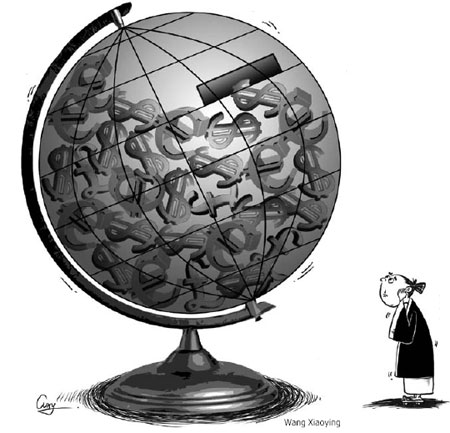
|
OPINION> OP-ED CONTRIBUTORS
 |
|
Yen and the art of currency maintenance
By Andrew Sheng (China Daily)
Updated: 2009-08-27 07:51 Japan ($4.8 trillion in GDP last year) is the largest economy in the world after the US ($14.3 trillion). Because it has continuously run current account surpluses; it also had the largest net foreign exchange position, namely more foreign exchange assets than liabilities, with $5 trillion in gross foreign exchange assets and $3.1 trillion in net foreign exchange assets at the end of September 2008. In contrast, China had $4.4 trillion in GDP, $2.3 trillion in gross foreign exchange assets and $1 trillion in net foreign exchange assets at the end of 2007. In other words, Japan still has three times bigger net foreign exchange assets than China, even though the latter has more foreign exchange reserves. In the 1960s, when the yen was still fixed at 360 to a US dollar, the Japanese economy grew at an average of 10 percent a year. In the 1970s, when the yen began to appreciate and there was an oil shock, the growth slowed to an average of 5 percent.
According to economic textbooks, a country with a continuous surplus should have an appreciating currency. It is interesting to note that Japan had a continuous current account surplus despite the volatile yen. Indeed, Japan had to export capital in large amounts in order to keep the yen at a competitive level. In the 1980s, Japan began to internationalize the yen in an effort to make it a global reserve currency and Tokyo an international financial center. But after nearly 17 years of dismal economic growth, when its economy at best grew between 1 and 2 percent, the role of the yen has declined along with the number of foreign companies listed on the Tokyo Stock Exchange. Why did the yen not succeed as an international reserve currency? After all, Japan had actively promoted the yen by granting considerable amount of cheap official aid in yen loans. Japanese banks branched out overseas in the 1980s and granted substantial yen loans abroad. Because yen interest rates were cheap, initially many countries borrowed in yen, but very soon discovered that the high volatility in the dollar-yen rate made the Japanese currency quite costly to hedge and to borrow.
 The reason why the yen was pushed as an international reserve currency and Tokyo as a global financial hub was strategic. Because of its aging population, Japan wanted to shift from being an exporter of manufacturing goods to a surplus country with long-term income from its savings. If the yen was an international reserve currency, the Bank of Japan could earn seigniorage - an interest free loan from foreigners using the yen as reserve currency. Furthermore, Tokyo could earn services income as a global financial hub dealing with yen securities, currency trading and commercial services. The failure of the yen to become a major reserve currency status despite Japan's wealth and industrial power is strange. Three factors help a currency become an international reserve currency: Stable value, low transaction costs and high transparency. Unfortunately, the yen has been very volatile and transaction costs for dealing in the yen is not cheap. Several reasons, especially wrong policies, were to blame for the yen's volatility. First, Japan's position as a major exporter of yen meant that there was a yen "overhang". A Japanese investor in US treasuries earning a spread of say 4 percent between the US Treasury rate and Japanese deposit rate could find his income wiped out if the yen appreciated more than 4 percent a year, which happened quite often. A Thai borrower in yen, however, would find an appreciation in yen wiping out even the lower borrowing cost of the yen compared with the Thai baht or US dollar. The borrower, however, would be naturally hedged if he earns an income in yen. Nevertheless, the long-term tendency of the yen to appreciate prompted Japanese exporters to opt for exporting in yen and importing in dollars to protect their income in yen terms and save on import costs if the yen appreciated. This practice of passing the foreign exchange costs to the borrowers made the yen more volatile, because when it began appreciating the borrower and the investor both sold dollars to buy yen to protect themselves from the appreciation, causing the yen to go through large swings. A currency can only be an international reserve currency if it has a wide variety of financial and real assets to purchase in liquid markets. Because of the massive asset bubble in Japan in 1989, the basic trend of financial assets and real estate has been downward and yields on Japanese bonds, stocks and bank deposits are low under the near zero interest rate policy. Hence, the dollar-yen turnover steadily declined to 13 percent of global foreign currency turnover in 2007 compared with 20 percent in 1998. And the position of the yen as an international reserve currency suffered further with the rise of the euro in 1999. The author is Adjunct Professor in University of Malaya and Tsinghua University. (China Daily 08/27/2009 page9) |
|||||